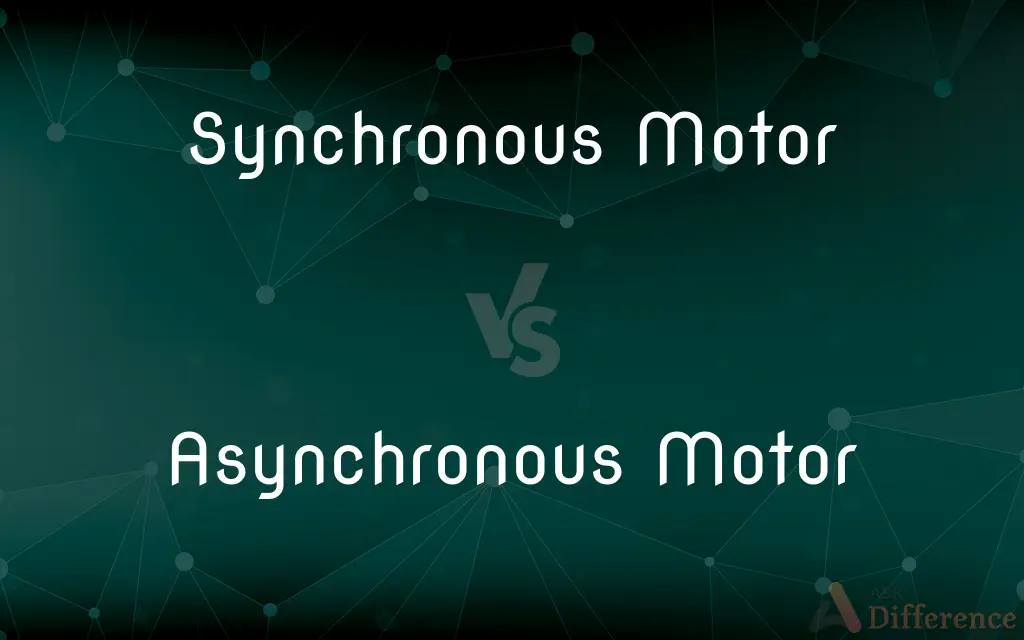Synchronous Motor vs. Asynchronous Motor — What's the Difference?
Edited by Tayyaba Rehman — By Fiza Rafique — Published on December 2, 2023
"Synchronous motors rotate at the grid frequency; asynchronous motors don't. The former aligns speed with electrical current, the latter doesn't."

Difference Between Synchronous Motor and Asynchronous Motor
Table of Contents
ADVERTISEMENT
Key Differences
"A Synchronous Motor is a type of electric motor that operates in time with, and at the speed of, the frequency of the supply current; its rotation period is synchronous with the frequency of the supply current. On the other hand, an Asynchronous Motor, also known as an induction motor, operates at a speed less than its synchronous speed; the rotor rotates slower than the frequency of the supply current."
"The Synchronous Motor requires direct current (DC) electricity for its rotor to rotate at synchronous speed, meaning the speed of the rotor and the stator's magnetic field are the same. However, the Asynchronous Motor uses an alternating current (AC); its rotor never achieves the synchronous speed of the stator's magnetic field, operating at what's called 'slip speed.'"
"In terms of efficiency, a Synchronous Motor is generally more efficient as it operates at a constant speed under varying loads, maintaining power factor control. Conversely, the Asynchronous Motor experiences slip, meaning the rotor speed fluctuates based on load, often resulting in less efficient operation."
"Synchronous Motors are usually more complex, needing a separate DC power source for the rotor, making them costly and less robust compared to Asynchronous Motors, which are simpler in construction, cheaper, and require less maintenance as they do not need an additional power source."
"The application of a Synchronous Motor is common in tasks that require precision and high performance, like in robotics, clocks, or sensor systems. Whereas, an Asynchronous Motor is more commonly found in pumps, compressors, and small fixed-speed applications due to its simplicity and ruggedness."
ADVERTISEMENT
Comparison Chart
Connection to Grid
Operates in time with the electrical grid frequency.
Operates independently of the electrical grid frequency.
Speed
Speed is constant and matches the grid frequency.
Speed varies and is less than the grid frequency.
Efficiency
Generally more efficient; maintains constant speed.
Less efficient; speed fluctuates with load.
Complexity
More complex, requires an additional DC power source.
Simpler, no additional power source needed.
Applications
Used in precision tasks requiring high performance.
Common in simpler, fixed-speed applications.
Compare with Definitions
Synchronous Motor
A Synchronous Motor is an AC motor where the rotor spins at the same speed as the motor’s internal rotating magnetic field."
The precision of the Synchronous Motor makes it perfect for the robotic assembly line.
Asynchronous Motor
"An Asynchronous Motor is one where the electric current in the rotor needed to produce torque is obtained by electromagnetic induction."
The Asynchronous Motor in my washing machine makes it efficiently handle varying loads.
Synchronous Motor
"Synchronous Motors maintain constant speed and torque regulation under variable loads."
We installed a Synchronous Motor in the mill to ensure consistent grinding speeds.
Asynchronous Motor
"Asynchronous Motors, or induction motors, have a rotor rotating at a speed less than that of the stator field."
The fans use Asynchronous Motors, as precise speed control is not crucial.
Synchronous Motor
"These motors are called 'synchronous' because the speed of the rotor and stator magnetic field is the same."
The Synchronous Motor in the old clock tower ensures accurate timekeeping.
Asynchronous Motor
"These motors are highly reliable and require less maintenance due to the absence of brushes or commutators."
We chose the Asynchronous Motor for our pumps due to its low-maintenance nature.
Synchronous Motor
"Synchronous Motors require a DC source for the rotor, either from a separate source or internally from a DC generator."
Maintaining the Synchronous Motor's DC supply is crucial for its operation.
Asynchronous Motor
"Asynchronous Motors are rugged and have a simple design, making them popular for industrial uses."
Due to its durability, the Asynchronous Motor is preferred for the factory's conveyor system.
Synchronous Motor
"Synchronous Motors help in improving power factor, often used in power-sensitive industries."
To avoid penalties for poor power factor, the plant uses Synchronous Motors.
Asynchronous Motor
"The speed of an Asynchronous Motor’s rotor differs from the speed of the magnetic field, known as 'slip.'"
In Asynchronous Motors, the slip increases with heavier loads, reducing the speed.
Common Curiosities
What's a key benefit of using a Synchronous Motor?
Synchronous Motors maintain efficiency and speed consistency under variable loads, beneficial for power-sensitive industries.
What defines a Synchronous Motor's speed?
A Synchronous Motor's speed is defined by the supply current's frequency and the motor's construction.
Can Asynchronous Motors operate at synchronous speed?
No, Asynchronous Motors always operate slightly below synchronous speed, due to the slip necessary to induce current in the rotor.
Why are Asynchronous Motors considered rugged and reliable?
Asynchronous Motors have a simple design with fewer parts to fail, making them durable and low-maintenance.
Do Asynchronous Motors offer power factor control?
No, Asynchronous Motors don't offer power factor control and generally have a lower power factor.
How does an Asynchronous Motor's speed vary?
An Asynchronous Motor's speed varies based on the load, operating slower than the supply current frequency.
Is power factor control possible with a Synchronous Motor?
Yes, Synchronous Motors allow for power factor control, enhancing efficiency in power usage.
Are Synchronous Motors suitable for high-torque applications?
Yes, Synchronous Motors are suitable for high-torque, precision applications due to their consistent speed.
When is an Asynchronous Motor more applicable?
Asynchronous Motors are ideal for applications where speed variation is acceptable, like pumps or fans.
What's the complexity level in maintaining a Synchronous Motor?
Synchronous Motors are complex, requiring regular maintenance of their DC excitation system.
Why is a DC source necessary for a Synchronous Motor?
A DC source energizes the rotor, creating a magnetic field that interacts synchronously with the stator's field.
Can Asynchronous Motors handle high-torque operations?
Asynchronous Motors can handle high-torque but with speed variation, as torque increases with increased load (slip).
Can Synchronous Motors run directly from an AC supply?
No, Synchronous Motors require a separate DC supply for their rotor, unlike Asynchronous Motors that can run directly from an AC supply.
How maintenance-intensive are Asynchronous Motors?
Asynchronous Motors are less maintenance-intensive, due to their simpler, brushless design.
In what scenario is a Synchronous Motor preferred?
Synchronous Motors are preferred in applications requiring precise speed or timing, like in sensor systems or robotics.
Share Your Discovery

Previous Comparison
VXX vs. VIX
Next Comparison
Meta Tags vs. KeywordsAuthor Spotlight
Written by
Fiza RafiqueFiza Rafique is a skilled content writer at AskDifference.com, where she meticulously refines and enhances written pieces. Drawing from her vast editorial expertise, Fiza ensures clarity, accuracy, and precision in every article. Passionate about language, she continually seeks to elevate the quality of content for readers worldwide.
Edited by
Tayyaba RehmanTayyaba Rehman is a distinguished writer, currently serving as a primary contributor to askdifference.com. As a researcher in semantics and etymology, Tayyaba's passion for the complexity of languages and their distinctions has found a perfect home on the platform. Tayyaba delves into the intricacies of language, distinguishing between commonly confused words and phrases, thereby providing clarity for readers worldwide.
















































